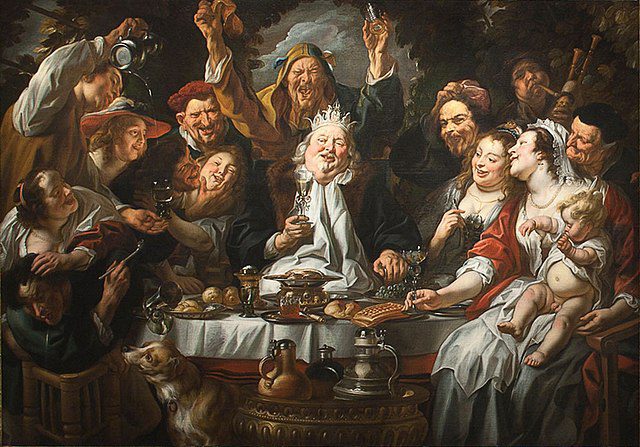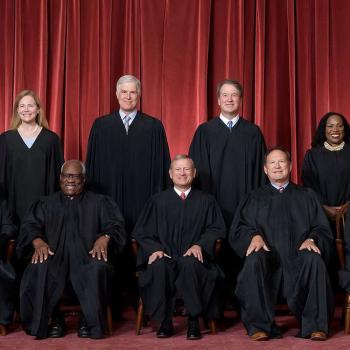Today is the last day of Christmas. The day for twelve drummers drumming! January 5 is known as Twelfth Night, a time for all kinds of merry-making, including playing practical jokes and letting some lowly person be “king for the day.”* This is also the traditional day for taking down the Christmas decorations. A good way to mark the occasion is to read Shakespeare’s comedy Twelfth Night.
So as Christmas draws to a close, here at the Cranach blog we will consume the last of our Christmas leftovers. Here are some tasty bits on that inexhaustible topic that we can never tire of: the Incarnation of our Lord.
Santa Claus vs. Artemis
You know by now that the real Santa Claus, St. Nicholas of Myra, was a participant at the Council of Nicaea, which gave us the Nicene Creed, which confesses so clearly what Christmas is all about. Supposedly at this council he slapped the heretic Arius, who taught against the deity of Christ.
Now Dylan Pahman in Religion & Liberty Online tells us how St. Nicholas also took on Artemis, the fertility goddess worshipped at Myra in his essay Santa Claus vs. Artemis.
By looking at both the historical record and the early legends that grew up around St. Nicholas, he shows how the good bishop not only opposed the worship of Artemis, but took her place as the patron of marriage, the harvest, the marketplace, and seafarers.
The Geneaologies of Christmas
Walter Russell Mead has been writing a series of blog posts for the Twelve Days of Christmas on Christianity and history at Providence Magazine. You can access those here. I was especially taken with Day 2: Rolling the Credits, in which we learn how it is evident that the Gospel writers were writing about Jesus as a real person from history, not as a mythological figure. I was also interested in his discussion of the genealogies. For example, here is what he says about the objection that if Jesus was born of a virgin, Joseph was not his biological father, so He couldn’t have been the descendant of David:
Belonging to a royal house in those days meant being acknowledged by the head of the house. This is how it worked for the Caesars. The Caesar we know as Augustus was the adopted son of Julius Caesar; his successor Tiberius was also adopted, and Tiberius in turn went on to adopt Caligula. More broadly, we should remember that paternity was a different thing in a pre-scientific age. In a world without DNA tests, if your mother’s husband acknowledged you as his son or his daughter, that was it. End of story. Joseph acknowledged Jesus as his son; Jesus was of the House of David, and His claim to the throne of David was as good as Tiberius Caesar’s claim to the throne of his adopted father Augustus. That at least is how it must have seemed to the Gospel writers.
What Christmas Did to the Family
Donald DeMarco writes about what Christmas did to the family in his article for the National Catholic Register, Christmas and Its Forgotten Message.
He points out that in the ancient world–as Mead is also emphasizing above–the center of the family was the Father. For the Greeks and the Romans, the father had the power of life or death over his children, exercised primarily in the choice of whether to let the baby live to be part of the family or to “expose” the child by leaving it in the countryside to die.
Today, the mother is the center of the family. She alone has the power of life or death over her children, exercised primarily in the choice of whether or not to have an abortion.
But in the Christmas story–from the Annunciation through the Flight to Egypt–the center of the family, for whose benefit the family is organized, is the Child. Christ’s mother too played an important role. The father, Joseph, contrary to the customs of the time, was very much in the background.
We’ll let DeMarco explain it:
In ancient Rome, the notion of paterfamilias prevailed. The expression is Latin for “father of the family” or the “owner of the family estate.” Accordingly, the oldest living male in a household, usually the father, could legally exercise autocratic authority over his extended family. The father ruled; the mother and child were ruled.
With Christianity, the family began to revolve around the child. The purpose of the family was to raise children, whom the mother and father would care for, support, and teach.
The new hierarchy — of the child, the mother, and the father — was to replace the old hierarchy — of the father, the mother, and the child. The humblest would reign, the mother would nurse, and the father would serve both his wife and their child. . . .
The often-forgotten message of Christmas is that the child is the center of the family and that the family is the center of the world.
Today, though, we have a new hierarchy:
In today’s world, the woman (married or single) is regarded as a “solo entity” in order to free herself to abort her child. The father of the family has no legal status to veto his wife’s choice to abort. In this way, in today’s secular world, the woman has replaced the man’s authority, while the child’s continued existence hangs on the thread of her choice.
We are back to the time when the child is at the lowest place, able to be killed, even, not at the whim of the father as in the ancient world, but at the whim of the mother.
Christmas, though, says DeMarco, has very different implications for the family. “By according the child centrality in the family, the whole world is changed for the better because the family’s identity has been transfigured from power to love.”
Postmodernists do believe that everything can be reduced to power, including marriage and parenting. One can sum up the difference between Christian values and those of our time by contrasting power and love.
*Twelfth Night was celebrated with a “King Cake,” now primarily associated with Mardi Gras. Whoever ate the piece of cake with a bean in it was honored as the “king for a day,” as in our featured painting, dated 1645, by the Dutch painter Jacob Jordaens. Other role-reversals might be included, with characters such as the Lord of Misrule and the Abbot of Unreason. See this and this.
Illustration: “The Bean King” [at Twelfth Night] by Jacob Jordaens – https://www.imj.org.il/en/exhibitions/jacob-jordaens, Public Domain, https://commons.wikimedia.org/w/index.php?curid=114060816














